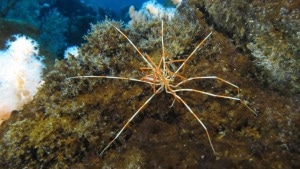Until recently, scientists have spent more than 140 years largely ignorant of the reproduction of giant sea spiders in Antarctica.
 Giant Antarctic sea spider. Image Credit: R. Robbins
Giant Antarctic sea spider. Image Credit: R. Robbins
Scientists from the University of Hawaiʻi at Mānoa visited the isolated continent to observe these enigmatic creatures up close, and their observations may have broader effects on marine life and ocean ecosystems in Antarctica and beyond.
A class of invertebrates resembling spiders, known as pycnogonids, are found in marine environments all over the world. The majority of species are no larger than a fingernail, however, some Antarctic species can stretch their legs more than a foot from one tip to the tip of the other.
These creatures are well-known examples of a phenomenon known as “polar gigantism,” in which some organisms in polar regions - like the Arctic and Antarctic - grow significantly larger than their counterparts in temperate regions.
In most sea spiders, the male parent takes care of the babies by carrying them around while they develop. What’s weird is that despite descriptions and research going back over 140 years, no one had ever seen the giant Antarctic sea spiders brooding their young or knew anything about their development.”
Amy Moran, Professor and Study Lead Researcher, School of Life Sciences, University of Hawaiʻi
For over 10 years, the Moran lab has been researching polar gigantism. The team, which included Moran and PhD candidates Aaron Toh and Graham Lobert from the School of Life Sciences, made a ground-breaking discovery in October 2021 while on a field research expedition in Antarctica.
They hand-collected groups of enormous sea spiders that looked to be mating by diving beneath the ice, and they then took the spiders to observation tanks.
They were shocked to discover that thousands of tiny eggs were laid by two distinct mating groups. As in most species of sea spiders, one parent (probably the father) attached the eggs to the rocky bottom where they developed for several months before hatching as tiny larvae. This is in contrast to most species of sea spiders, which carry the babies until they hatch. In February 2024, Ecology published the researchers’ findings.
We were so lucky to be able to see this. The opportunity to work directly with these amazing animals in Antarctica meant we could learn things no one had ever even guessed.”
Aaron Toh, PhD Candidate, School of Life Sciences, University of Hawaiʻi
The eggs were perfectly camouflaged with microscopic algae within weeks of their laying.
Graham Lobert says, “We could hardly see the eggs even when we knew they were there, which is probably why researchers had never seen this before.”
Breakthrough Research
The general ecology and reproductive biology of Antarctic marine species remains overwhelmingly unknown and we have data on only a handful of species, so papers like this one are of huge importance in shedding light on how animals function in one of the least studied parts of the world’s ocean.”
Lloyd Peck, Renowned Antarctic Biologist, British Antarctic Survey
The UH Mānoa School of Life Sciences is housed in the College of Natural Sciences.
Giant Antarctic sea spiders 140-year-old reproductive mystery solved
Video Credit: University of Hawaiʻi
Source:
Journal reference:
Moran, L. A., et al. (2024) Spawning and larval development of Colossendeis megalonyx, a giant Antarctic sea spider. Ecology. doi.org/10.1002/ecy.4258